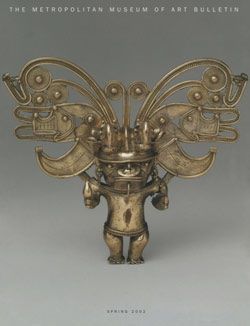Necklace Beads
Not on view
Necklaces of composed of large gold or silver beads are closely associated with high-status individuals in ancient Peru. Such necklaces are among the most striking works to have been found in elite burials of the Moche culture on Peru’s North Coast (Bourget, 2014; Alva and Donnan, 1993; Donnan, 2022). These three (of seven) beads, said to have been found with a second set of beads (see MMA 1974.271.32), once formed part an impressive necklace created for a high-ranking dignitary.
Each bead illustrates the figure of a fearsome being. The beads were created from hammered gold sheet worked from behind to create the figures in a technique known as repoussé. The standing figure wears a patterned tunic with a double headed serpent belt. Streamers emerge from his head, and the eyes and mouth were likely once inlaid with shell or colorful stones. This figure is reminiscent of the fierce face depicted in the brightly painted architectural reliefs at an important Moche site now known as Huaca de la Luna, in the Moche Valley on Peru’s North Coast. Similar faces are repeated across the interior walls in the Great Patio, in the lower level (Uceda Castillo, 2001: 55, fig. 11).
Each bead is composed of two halves soldered together and each contained small pellets that rattled as the wearer moved. Necklace beads were generally between 3 and 8 cm in width, although other beads as large as 12 cm have been described (see, for example MMA 1974.271.34; Alva and Donnan; 1993; Bourget, 2014; Donnan, 2022). Moche dignitaries were usually buried with multiple necklaces. Each strand would be composed of beads of the same dimensions, but the dimensions of the beads differed between strands; the outer strand would usually have larger beads and the strand closer to the neck would feature smaller beads. Beads with images of warriors, spiders, snails, frogs, felines, peanuts, owl and monkey heads, as well as geometrical forms have been found in both gold and silver, and sometimes as combinations of the two metals. The large beads in Moche necklaces usually did not extend to the nape, as shown on their ceramics and inferred by excavated examples.
The Moche (also known as the Mochicas) flourished on Peru’s North Coast from 200-900 CE, centuries before the rise of the Incas (Castillo, 2017). Over the course of some seven centuries, the Moche built thriving regional centers from the Nepeña River Valley in the south to perhaps as far north as the Piura River, near the modern border with Ecuador, developing coastal deserts into rich farmlands and drawing upon the abundant maritime resources of the Pacific Ocean’s Humboldt Current. Although it is not certain whether the Moche formed a single centralized state, they shared unifying cultural traits such as religious practices (Donnan, 2010).
References and Further Reading
Alva, Walter, and Christopher B. Donnan. Royal Tombs of Sipán. Los Angels: Fowler Museum of Cultural History, University of California, 1993.
Bourget, Steve. Les rois mochica: Divinité et pouvoir dans le Pérou ancient. Paris: Somogy éditions d'art; Geneva: MEG, Musée d'ethnographie de Genève, 2014.
Castillo, Luis Jaime. “Masters of the Universe: Moche Artists and Their Patrons.” In Golden Kingdoms: Luxury Arts in the Ancient Americas, edited by Joanne Pillsbury, Timothy Potts, and Kim N. Richter, pp. 24-31. Los Angeles: J. Paul Getty Museum, 2017.
Donnan, Christopher B. “Moche State Religion.” In New Perspectives on Moche Political Organization, edited by Jeffrey Quilter and Luis Jaime Castillo, pp. 47-69. Washington D.C.: Dumbarton Oaks Research Library and Collection, 2010.
Donnan, Christopher A. La Mina: A Royal Moche Tomb. Albuquerque: University of New Mexico Press, 2022.
Uceda Castillo, Santiago. “Investigations at Huaca de la Luna, Moche Valley: An Example of Moche Religious Architecture.” In Moche Art and Archaeology in Ancient Peru, edited by Joanne Pillsbury, pp. 47-67. Washington, D.C.: National Gallery of Art, 2001.
This image cannot be enlarged, viewed at full screen, or downloaded.


